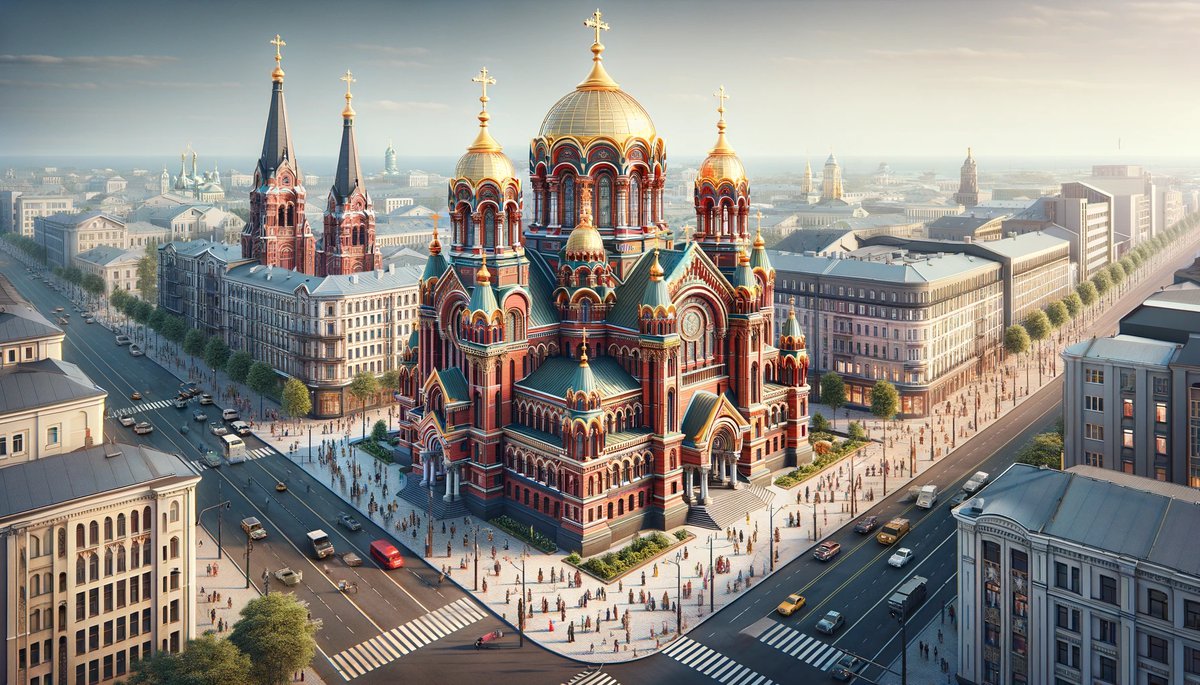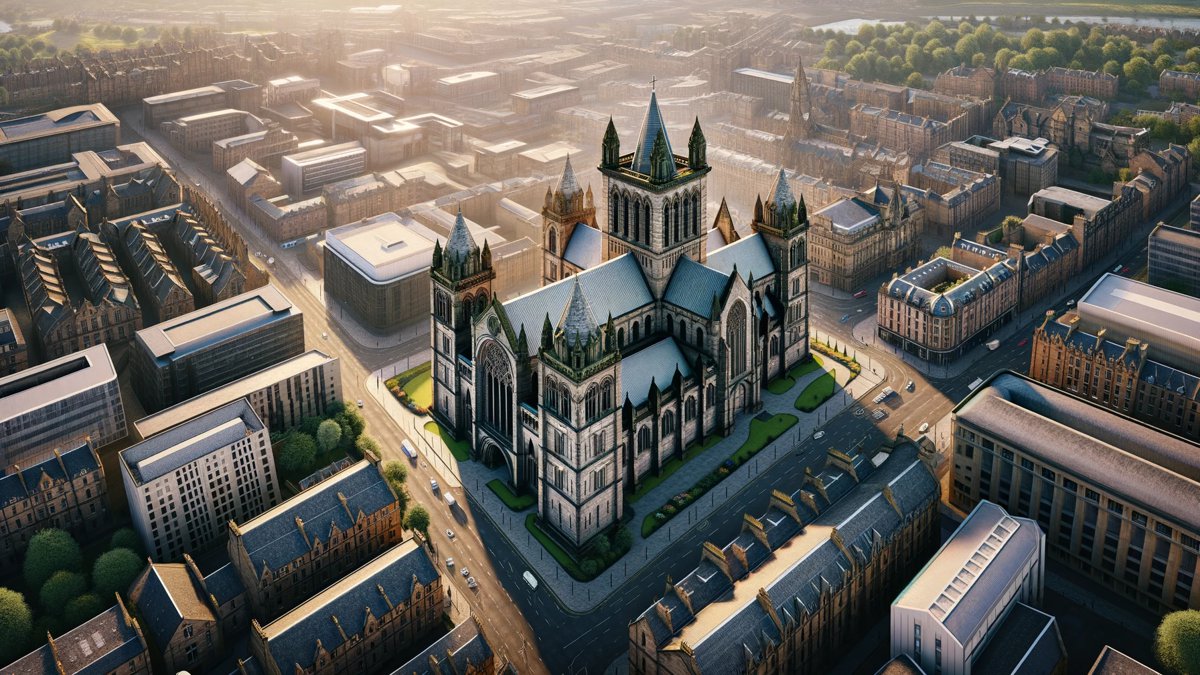Home>Arts and Culture>Where Is The Uspenski Cathedral?


Arts and Culture
Where Is The Uspenski Cathedral?
Published: February 17, 2024
Ericka Andersen, an editor at Christian.net, expertly merges digital strategy with content creation, focusing on faith and societal issues. Her communication skills enhance the platform's engaging narratives, fostering meaningful dialogue on belief's impact on society.
Discover the iconic Uspenski Cathedral in Helsinki and immerse yourself in the city's rich arts and culture scene. Explore its history and significance today!
(Many of the links in this article redirect to a specific reviewed product. Your purchase of these products through affiliate links helps to generate commission for Christian.net, at no extra cost. Learn more)
Table of Contents
Introduction
The Uspenski Cathedral, an iconic symbol of Finnish cultural heritage, stands proudly atop a hill overlooking the city of Helsinki. This magnificent Orthodox cathedral, with its striking red-brick façade and distinctive onion domes, is a testament to the rich history and architectural grandeur of the region. As one of the most visited attractions in Helsinki, the Uspenski Cathedral draws inquisitive travelers, history enthusiasts, and architecture aficionados from around the world.
The cathedral's imposing presence and intricate details offer a captivating glimpse into the past, inviting visitors to immerse themselves in a world of religious significance and artistic splendor. Whether you are drawn to its spiritual ambiance, awe-inspiring design, or panoramic views of the city, the Uspenski Cathedral promises a memorable experience that transcends time and culture.
As we delve into the history, architectural features, and practical details of visiting this cultural gem, you will uncover the allure and significance of the Uspenski Cathedral, gaining a deeper appreciation for its place in the heart of Helsinki.
Read more: Where Is Canterbury Cathedral
History of the Uspenski Cathedral
The history of the Uspenski Cathedral is deeply intertwined with the cultural and religious tapestry of Finland. Construction of this magnificent Orthodox cathedral began in the mid-19th century, during a period of significant cultural and political change in the region. Designed by the celebrated Russian architect Aleksey Gornostayev, the cathedral was erected on a prominent hill in the Katajanokka district of Helsinki, overlooking the city and the sea.
The cathedral's construction was closely linked to the broader geopolitical dynamics of the time, as Finland was then a Grand Duchy of the Russian Empire. The Uspenski Cathedral served as a bold statement of the Russian Orthodox Church's presence in the heart of Helsinki, reflecting the influence of Russian culture and religion in the region.
The name "Uspenski" itself holds historical and religious significance, derived from the Russian word "uspenskii," meaning "Dormition." The cathedral is dedicated to the Dormition of the Theotokos, a major feast in the Eastern Orthodox Church commemorating the death, resurrection, and glorification of the Virgin Mary.
Throughout its history, the Uspenski Cathedral has weathered the tides of change, bearing witness to Finland's journey towards independence and its evolving relationship with Russia. Despite the shifting political landscapes and conflicts of the 20th century, the cathedral has remained a steadfast symbol of Finnish cultural heritage and religious diversity.
Today, the Uspenski Cathedral stands as a living testament to the enduring legacy of Orthodox Christianity in Finland and the architectural prowess of its creators. Its rich history and cultural significance continue to draw visitors from near and far, offering a glimpse into the past while embodying the spirit of unity and reverence that transcends borders and time.
The Uspenski Cathedral's history is a compelling narrative of faith, artistry, and resilience, reflecting the intricate threads that weave together the tapestry of Finnish identity and heritage. As visitors explore its hallowed halls and gaze upon its resplendent domes, they are invited to partake in a journey through time, embracing the cathedral's storied past and the enduring legacy it represents.
Architectural Features
The Uspenski Cathedral's architectural splendor is a captivating fusion of Byzantine and Russian architectural styles, creating a visual masterpiece that commands attention and admiration. The cathedral's exterior, adorned with vibrant red bricks and striking onion domes, immediately captures the imagination and transports visitors to a realm of timeless beauty and spiritual significance.
The cathedral's design reflects the traditional architectural elements found in Russian Orthodox churches, with its prominent use of onion domes, ornate arches, and intricate detailing. The five distinctive onion domes, coated in glistening gold leaf, stand as a testament to the cathedral's grandeur and the enduring legacy of Russian architectural influence in Finland.
As visitors approach the cathedral, they are greeted by a series of steps leading to the main entrance, flanked by ornate columns and intricate carvings that exude a sense of reverence and grandeur. The exterior walls, constructed from rich red bricks, create a striking contrast against the surrounding landscape, adding to the cathedral's commanding presence atop the hill.
Upon entering the cathedral, visitors are enveloped in a world of opulent beauty and spiritual tranquility. The interior features a harmonious blend of vibrant iconography, intricate wood carvings, and gilded decorations, all illuminated by the soft glow of candlelight. The iconostasis, a visually stunning partition adorned with religious icons, serves as the focal point of the cathedral's interior, drawing the gaze of visitors and evoking a sense of reverence and awe.
The architectural details within the Uspenski Cathedral are a testament to the skilled craftsmanship and unwavering dedication of its creators. From the meticulously painted frescoes depicting religious scenes to the intricately carved wooden furnishings, every element within the cathedral reflects a profound commitment to preserving the traditions and artistic heritage of the Orthodox faith.
The Uspenski Cathedral's architectural features stand as a testament to the enduring legacy of Russian Orthodox influence in Finland, offering visitors a glimpse into a world of timeless beauty, spiritual devotion, and cultural significance. As one stands in awe of the cathedral's architectural grandeur, it becomes evident that every facet of its design is imbued with a profound sense of history, faith, and artistic excellence.
Location and Directions
The Uspenski Cathedral is strategically situated atop a hill in the Katajanokka district of Helsinki, Finland. Its commanding position offers breathtaking panoramic views of the city and the serene waters of the Baltic Sea, making it a prominent landmark that beckons visitors to embark on a journey of cultural and spiritual discovery.
For those seeking to visit this architectural marvel, reaching the Uspenski Cathedral is a straightforward yet enchanting endeavor. Whether arriving by foot, public transportation, or private vehicle, the cathedral's location ensures accessibility for travelers from all corners of Helsinki.
By Foot
Travelers with a penchant for exploration and a desire to soak in the city's ambiance may opt to reach the cathedral on foot. From the heart of Helsinki, a leisurely stroll along the picturesque waterfront promenade presents an opportunity to savor the city's charm while making one's way to the cathedral. The scenic route offers glimpses of Helsinki's architectural wonders and tranquil parks, creating a delightful prelude to the grandeur that awaits atop the hill.
Read more: Where Is Truro Cathedral
Public Transportation
Helsinki's efficient public transportation system provides convenient access to the Uspenski Cathedral. Visitors can board a tram or bus to reach the cathedral, with several routes connecting the cathedral to various parts of the city. The ease of navigating Helsinki's public transit network ensures that travelers can embark on a seamless journey to the cathedral, immersing themselves in the city's vibrant atmosphere along the way.
Private Vehicle
For those preferring the flexibility of traveling by car, reaching the Uspenski Cathedral is a straightforward endeavor. Ample parking facilities in the vicinity of the cathedral cater to visitors arriving by private vehicle, offering a convenient option for those seeking to explore the cathedral and its surroundings at their own pace.
Upon arrival at the Uspenski Cathedral, visitors are greeted by the sight of its majestic red-brick façade and iconic onion domes, signaling the beginning of an enriching and immersive experience. The cathedral's location and accessibility ensure that travelers can embark on a captivating journey to explore its historical and architectural wonders, creating lasting memories of their time in Helsinki.
Whether arriving on foot, via public transportation, or by private vehicle, the journey to the Uspenski Cathedral is a prelude to the awe-inspiring encounter that awaits atop the hill, inviting visitors to partake in a captivating exploration of Finnish cultural heritage and architectural magnificence.
Visiting Hours and Admission
The Uspenski Cathedral welcomes visitors to immerse themselves in its timeless beauty and spiritual ambiance during designated visiting hours. Whether you are a history enthusiast, a connoisseur of architectural marvels, or a traveler seeking to delve into the cultural tapestry of Helsinki, the cathedral offers a captivating experience that transcends time and tradition.
Visiting Hours:
- The cathedral is open to visitors from [specific opening time] to [specific closing time] on [days of the week]. This schedule allows ample time for visitors to explore the cathedral's interior, admire its architectural splendor, and partake in moments of quiet reflection within its hallowed halls.
Admission:
- Admission to the Uspenski Cathedral is free of charge, welcoming all who wish to discover its historical and cultural significance. This inclusive approach ensures that visitors from diverse backgrounds and walks of life can partake in the cathedral's allure without any barriers, fostering a sense of unity and shared appreciation for its profound legacy.
Guided Tours:
- For those seeking a deeper understanding of the cathedral's history, architectural features, and religious significance, guided tours are available at specified times. Knowledgeable guides lead visitors through the cathedral, offering insights into its rich heritage and the stories woven into its walls. The guided tours provide a unique opportunity to gain a deeper appreciation for the cathedral's significance and the artistry infused into every aspect of its design.
As visitors step through the cathedral's entrance, they are greeted by a world of opulent beauty and spiritual tranquility, inviting them to embark on a journey through history and faith. The visiting hours and admission policies are designed to ensure that all who are drawn to the Uspenski Cathedral can partake in its splendor, fostering a sense of inclusivity and cultural enrichment for visitors from near and far.
Whether you choose to explore the cathedral's wonders independently or join a guided tour to uncover its hidden treasures, the Uspenski Cathedral promises an enriching experience that resonates with the spirit of Helsinki's cultural heritage. As visitors depart from the cathedral, they carry with them the echoes of its storied past and the enduring legacy it represents, creating lasting memories of their encounter with this architectural gem atop the hill.
The Uspenski Cathedral's visiting hours and admission policies reflect its commitment to sharing its cultural and spiritual significance with the world, inviting visitors to partake in a journey of discovery and reverence within its sacred walls.
Nearby Attractions
The Uspenski Cathedral, nestled within the heart of Helsinki, is surrounded by a tapestry of cultural, historical, and natural wonders that beckon visitors to explore the city's vibrant offerings. From architectural marvels to serene waterfront promenades, the vicinity of the cathedral teems with attractions that enrich the traveler's experience and offer a captivating glimpse into the soul of Helsinki.
Read more: Where Is The Chartres Cathedral
Senate Square
A short stroll from the Uspenski Cathedral leads to the iconic Senate Square, a historic hub adorned with neoclassical architectural splendor. The Helsinki Cathedral, with its striking white façade and towering green domes, presides over the square, creating a captivating juxtaposition of architectural styles. Visitors can immerse themselves in the square's ambiance, admire the statue of Emperor Alexander II, and revel in the timeless elegance of this cultural landmark.
Market Square
For those seeking a taste of Helsinki's bustling energy and culinary delights, the Market Square awaits just a stone's throw from the Uspenski Cathedral. Here, a vibrant open-air market comes to life, offering an array of fresh produce, local crafts, and delectable Finnish delicacies. Visitors can savor the flavors of traditional Finnish cuisine, engage with local artisans, and soak in the lively atmosphere of this waterfront marketplace.
Helsinki Skywheel
A short jaunt from the cathedral brings visitors to the Helsinki Skywheel, a modern marvel that offers panoramic views of the city and its picturesque surroundings. Ascending to the skies in climate-controlled gondolas, visitors are treated to breathtaking vistas of Helsinki's skyline, the Baltic Sea, and the archipelago beyond. The Helsinki Skywheel presents an opportunity to witness the city from a new perspective, capturing the essence of Helsinki's allure from a lofty vantage point.
Esplanadi Park
Nestled amidst the bustling city center, Esplanadi Park invites visitors to unwind in a tranquil oasis of greenery and serenity. The park's tree-lined pathways, vibrant flowerbeds, and open-air cafes create an idyllic setting for leisurely strolls and moments of relaxation. Whether basking in the beauty of the park's natural surroundings or partaking in a leisurely picnic, visitors can savor the harmonious blend of nature and urban charm that defines Esplanadi Park.
Read more: Where Is Saint Louis Cathedral?
Suomenlinna Sea Fortress
A short ferry ride from the Uspenski Cathedral transports visitors to the Suomenlinna Sea Fortress, a UNESCO World Heritage site steeped in history and maritime grandeur. This historic fortress complex, spread across a cluster of interconnected islands, offers a captivating journey through centuries of military prowess and architectural ingenuity. Visitors can explore the fortress's fortifications, museums, and scenic coastal paths, immersing themselves in a world of historical intrigue and natural beauty.
As visitors explore the vicinity of the Uspenski Cathedral, they are presented with a tapestry of attractions that celebrate Helsinki's rich heritage, architectural prowess, and natural splendor. Each nearby attraction offers a unique facet of the city's charm, inviting visitors to embark on a captivating journey of cultural discovery and immersive experiences. Whether admiring architectural marvels, savoring local flavors, or delving into the city's historical legacy, the nearby attractions complement the allure of the Uspenski Cathedral, creating a multifaceted tapestry of exploration and enchantment within the heart of Helsinki.
Conclusion
In the heart of Helsinki, the Uspenski Cathedral stands as a timeless testament to the intertwining narratives of faith, history, and architectural grandeur. As visitors bid farewell to this iconic landmark, they carry with them the echoes of its storied past and the enduring legacy it represents. The cathedral's resplendent onion domes, vibrant red-brick façade, and opulent interior serve as a poignant reminder of the enduring cultural heritage and spiritual significance it embodies.
The journey through the Uspenski Cathedral is a captivating exploration of Finnish identity, religious diversity, and the enduring influence of Russian Orthodox tradition. From its rich history as a symbol of Russian presence in Helsinki to its role as a beacon of Finnish cultural heritage, the cathedral weaves together a tapestry of narratives that resonate with visitors from around the world.
As visitors depart from the cathedral, they carry with them a profound appreciation for the architectural prowess, religious devotion, and historical significance that define the Uspenski Cathedral. The memories of its resplendent interior, panoramic views, and the tranquil ambiance within its hallowed halls linger as a testament to the enduring allure of this architectural gem atop the hill.
The Uspenski Cathedral's legacy transcends time and borders, inviting visitors to partake in a journey of cultural enrichment and spiritual reverence. Whether drawn to its architectural splendor, historical significance, or panoramic vistas, the cathedral leaves an indelible impression on all who traverse its sacred thresholds.
As the sun sets over Helsinki, the Uspenski Cathedral stands as a silent sentinel, bearing witness to the passage of time and the ever-evolving tapestry of Finnish culture. Its enduring presence atop the hill serves as a beacon of unity, inviting visitors to embrace the cathedral's rich heritage and the profound stories etched into its walls.
In the heart of Helsinki, the Uspenski Cathedral stands as a timeless testament to the intertwining narratives of faith, history, and architectural grandeur. As visitors bid farewell to this iconic landmark, they carry with them the echoes of its storied past and the enduring legacy it represents. The cathedral's resplendent onion domes, vibrant red-brick façade, and opulent interior serve as a poignant reminder of the enduring cultural heritage and spiritual significance it embodies.
The journey through the Uspenski Cathedral is a captivating exploration of Finnish identity, religious diversity, and the enduring influence of Russian Orthodox tradition. From its rich history as a symbol of Russian presence in Helsinki to its role as a beacon of Finnish cultural heritage, the cathedral weaves together a tapestry of narratives that resonate with visitors from around the world.
As visitors depart from the cathedral, they carry with them a profound appreciation for the architectural prowess, religious devotion, and historical significance that define the Uspenski Cathedral. The memories of its resplendent interior, panoramic views, and the tranquil ambiance within its hallowed halls linger as a testament to the enduring allure of this architectural gem atop the hill.
The Uspenski Cathedral's legacy transcends time and borders, inviting visitors to partake in a journey of cultural enrichment and spiritual reverence. Whether drawn to its architectural splendor, historical significance, or panoramic vistas, the cathedral leaves an indelible impression on all who traverse its sacred thresholds.
As the sun sets over Helsinki, the Uspenski Cathedral stands as a silent sentinel, bearing witness to the passage of time and the ever-evolving tapestry of Finnish culture. Its enduring presence atop the hill serves as a beacon of unity, inviting visitors to embrace the cathedral's rich heritage and the profound stories etched into its walls.












